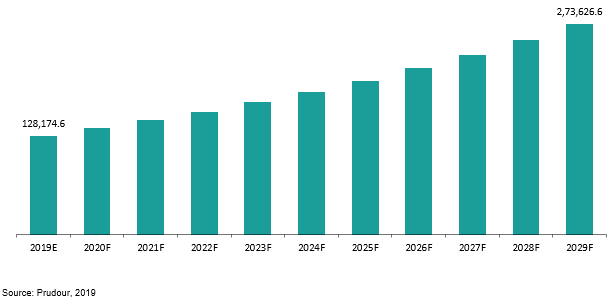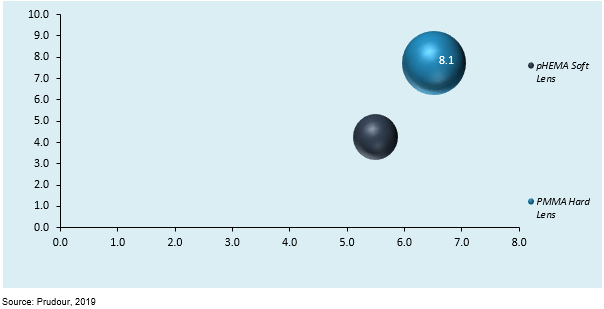Global Myopia Control Lens (Plastic Lens) Market by Type (pHEMA Soft Lens & PMMA Hard Lens), By End User (Teenagers & Adults), By Region, and Key Companies - Industry Segment Outlook, Market Assessment, Competition Scenario, Trends and Forecast 2022-2031
- Published date: Apr 2022
- Report ID: 68346
- Number of Pages: 222
- Format:
- keyboard_arrow_up
Market.us announces the publication of its most recently generated research report titled, “Global Myopia Control Lens (Plastic Lens) Market by Type (pHEMA Soft Lens & PMMA Hard Lens), By End User (Teenagers & Adults), and by Country – Global Forecast to 2028.”, which offers a holistic view of the global myopia control lens (plastic lens) market through systematic segmentation that covers every aspect of the target market.
The Global Myopia Control Lens (Plastic Lens) Market is projected to be US$ 128,174.6 Mn in 2019 to reach US$ 273,626.6 Mn by 2029 at a CAGR of 7.9%.
Myopia is also referred to as short-sightedness or near-sightedness. It affects the vision of a person, making distant objects appear blurry while near objects appear normal. There are several underlying factors that can cause myopia in a person, including hereditary factors, environmental factors, working for long hours focusing on closer objects, etc. Some people with undiagnosed myopia can also have headaches and eyestrain. According to recent estimates, around 30% of the total population is affected by myopia and is majorly affecting children and adolescents. This condition can be corrected by the usage of eyeglasses or contact lenses or by surgery. Either an optometrist or an ophthalmologist can diagnose myopia with a comprehensive eye examination, which includes examining the eye in detail and testing vision. The doctor will either prescribe spectacles or contact lenses for optical correction, depending on the nature of the case. Both glasses and contact lenses have their set of advantages and disadvantages for patients with myopia. Some benefits of spectacles include economical cost, higher eye safety, better handling, etc. while contact lenses provide better cosmesis, larger retinal image size, chances of reducing myopia progression, etc. Contact lenses or corrective eyeglasses are commonly used to treat myopia. It refocuses light onto the retina. Contact lenses can cause complications (e.g., dry eye, corneal distortion, immunologic reaction, infection), but maybe advantageous for activities where glasses are not practical (e.g., specific sports). In younger children, a technique called retinoscopy helps the eye doctor determine the correction required. There are several types of myopia that affect people, such as simple myopia, nocturnal myopia, pseudomyopia, degenerative myopia, and induced myopia.
trending_up Total Revenue in 2018$ 128,174.6 Mn
trending_up Market CAGR of the Next Ten Years7.9%
no_encryption Market Value (US$ Mn), Share (%) and Growth Rate (%) Comparison 2012-2028Purchase this report or a membership to unlock the market value (US$ Mn), share (%) and growth rate (%) comparison for this industry.- By Type
- By Region
- By Application
no_encryption Leading Companies Financial HighlightsPurchase this report or a membership to unlock the leading companies financial highlights for this industry.trending_up Market Revenue of the Next Ten Years$ 273,626.6 Mn
The increasing prevalence of myopia affecting a high percentage of the population is the primary factor anticipated to drive the growth of the global myopia control lens (plastic lens) market. According to Brien Holden Vision Institute: about 30% of the world population is affected by myopia, which is expected to rise to 50% by 2050, accounting for about 5 billion people.
Global Myopia Control Lens (Plastic Lens) Market Revenue (US$ Mn), 2019–2029

Several research studies have indicated that children wearing multifocal lenses had 25% less myopia progression and 31$ less axial elongation than those wearing single-vision glasses over two years. The recent introduction of multifocal contact lenses for children with myopia that can slow the progression of nearsightedness, providing a more effective and efficient treatment option can offer lucrative opportunities to the players in the target market, thereby augmenting the market growth further.
Technological advancements in the field of ophthalmology, such as the advent of refractive surgery. This eliminates the dependency on glasses or contact lenses by improving the refractive state of the eye, which is a significant challenge for the growth of the global myopia control lens market. Additionally, this surgery is highly affordable and safe and covered by medical insurance across various economies, which may subdue the growth of the target market.
Based on the type, the market is segmented into pHEMA Soft Lens and PMMA Hard Lens. The PMMA Hard Lens segment owns the majority share in the global myopia control lens (plastic lens) market, followed by pHEMA Soft Lens.
Based on the end-user, the market is segmented into teenagers and adults. The teenager segment owns the majority share in the global myopia control lens (plastic lens) market, followed by the adults segment.
Global Myopia Control Lens (Plastic Lens) Market Attractiveness Analysis by Type, 2019

Based on the country, the market is segmented into the USA, Japan, India, Europe, China, Southeast Asia, South America, South Africa, and the Rest of the World. Europe owns the majority share in the global myopia control lens (plastic lens) market, followed by China.
The research report on the global myopia control lens (plastic lens) market includes profiles of some of the major companies such as EssilorLuxottica, Alcon, Bausch Health, Carl Zeiss AG (Carl Zeiss), HOYA Corp., Brighten Optix, Mingyue Optical, Shanghai Weixing Optical Co., Ltd., and others.
Key Market Segments
Type
- pHEMA Soft Lens
- PMMA Hard Lens
Application
- Teenagers
- Adults
Key Market Players included in the report:
- EssilorLuxottica
- Alcon
- Bausch Health
- Carl Zeiss AG (Carl Zeiss)
- HOYA Corp.
- Brighten Optix
- Mingyue Optical
- Shanghai Weixing Optical Co.Ltd.
For the Myopia Control Lens (Plastic Lens) Market research study, the following years have been considered to estimate the market size:
Attribute Report Details Historical Years
2016-2020
Base Year
2021
Estimated Year
2022
Short Term Projection Year
2028
Projected Year
2023
Long Term Projection Year
2032
Report Coverage
Competitive Landscape, Revenue analysis, Company Share Analysis, Manufacturers Analysis, Volume by Manufacturers, Key Segments, Key company analysis, Market Trends, Distribution Channel, Market Dynamics, COVID-19 Impact Analysis, strategy for existing players to grab maximum market share, and more.
Regional Scope
North America, Europe, Asia-Pacific, South America, Middle East & Africa
Country Scope
United States, Canada and Mexico, Germany, France, UK, Russia and Italy, China, Japan, Korea, India and Southeast Asia, Brazil, Argentina, Colombia etc.Saudi Arabia, UAE, Egypt, Nigeria and South Africa
![Myopia Control Lens (Plastic Lens) Market Myopia Control Lens (Plastic Lens) Market]() Myopia Control Lens (Plastic Lens) MarketPublished date: Apr 2022add_shopping_cartBuy Now get_appDownload Sample
Myopia Control Lens (Plastic Lens) MarketPublished date: Apr 2022add_shopping_cartBuy Now get_appDownload Sample - EssilorLuxottica
- Alcon
- Bausch Health
- Carl Zeiss AG (Carl Zeiss)
- HOYA Corp.
- Brighten Optix
- Mingyue Optical
- Shanghai Weixing Optical Co.Ltd.
- settingsSettings
Our Clients
|
Single User
$5,999
$2,999
USD / per unit
save 50% |
Multi User
$7,999
$3,499
USD / per unit
save 55% |
Corporate User
$12,999
$4,499
USD / per unit
save 65% | |
|---|---|---|---|
| e-Access | |||
| Data Set (Excel) | |||
| Company Profile Library Access | |||
| Interactive Dashboard | |||
| Free Custumization | No | up to 10 hrs work | up to 30 hrs work |
| Accessibility | 1 User | 2-5 User | Unlimited |
| Analyst Support | up to 20 hrs | up to 40 hrs | up to 50 hrs |
| Benefit | Up to 20% off on next purchase | Up to 25% off on next purchase | Up to 30% off on next purchase |
| Buy Now ($ 2,999) | Buy Now ($ 3,499) | Buy Now ($ 4,499) |








